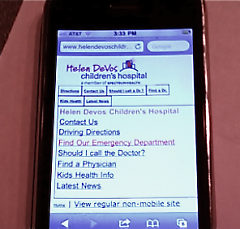“Minority Americans continue to outpace whites in their use of cell phone data applications.” In fact, according the research, 87% of Latinos have cell phones and over half of them use their phones to access the Internet (significantly outpacing white respondents in both categories). (Mobile Access 2010: Pew Internet & American Life Project, July 2010)
Quite recently, I was reading through the Predictions for Journalism 2011 series on the Nieman Journalism Lab website. Once again, many are claiming this is to be the “year of mobile.” Hardly earth-shattering as this prediction could easily have been cut and pasted from New Year tech blogs from 2010 or even 2009. What caught my eye however, was one prognosticator who put his predictions about mobile into a slightly different community context. Michael Andersen, editor, Portland Afoot (a monthly magazine about living the “low-car life in Portland”) predicts “2011 will be the year of media initiatives that serve poor and middle-income people.” And he bases that prediction squarely on the head of the mobile phone. According to Andersen’s read of the situation “one of the best things about the mobile Internet is that it’s finally killing (or even reversing) the digital divide."
At the same time, the Pew Research Center’s “Internet and American Life Project” reported in July of 2010, “Minority Americans continue to outpace whites in their use of cell phone data applications.” In fact, according the research, 87% of Latinos have cell phones and over half of them use their phones to access the Internet (significantly outpacing white respondents in both categories). This study has been pointed to as real progress, in that the digital divide has long been lamented as particularly detrimental to minority populations.
For those of us in community communication (as well as community service), this prediction is both hopeful and cautionary. If it proves correct, we will have new ways to reach, engage and empower more people. Cautionary however, because in my experience many organizations that seek to serve diverse sectors of the community have limited understanding of this communication trend, and few have designed mobile friendly delivery mechanisms for services and information.
"I don't know if it's the right time to celebrate. There are challenges still there," said Craig Watkins, an associate professor at the University of Texas at Austin in a recent article in the Washington Times. Watkins is the author of "The Young and the Digital." He adds: "We are much more engaged, but now the questions turn to the quality of that engagement, what are people doing with that access.”
While consumption of entertainment content is clearly becoming less “divided,” meaningful engagement opportunities and empowerment will only exist if the community service sector leverages the inherent power of mobile. According to Nonprofit Tech 2.0: “less than 1% of nonprofits have a mobile website on their To Do List. Nonprofits are quickly falling behind on this rapidly evolving, powerful web trend.”
Fortunately, there are leaders we can look to for inspiration. Goodwill Industries International maintains a mobile site where visitors can shop, donate, or even find a job. Locally, the Grand Rapids Community Foundation has a mobile site in development and the Downtown Alliance makes “on the go” eating and shopping easier with the mobile version of their interactive website. The Smartphone-optimized site for Helen DeVos Children’s Hospital provides quick driving directions to the ER. I have even read reports that the State of Michigan’s Department of Human Services is getting in on the act by developing a smart phone app to report abuse or fraud, or to “get help.” And The Rapidian? It’s time to practice what we preach as we work on collecting apps, configuring interfaces, and establishing practices for a mobile toolbox that will make it easier for would-be community reporters to engage with, and provide, hyper-local content via mobile phones.
While I can't imagine a day when filling out a job application will ever be practical on a mobile device, organizations trying to serve broad definitions of community need to pay attention to the trends. Otherwise, providers will provide in one way, but many we hope to serve will consume in a much different way, and this mobile divide will perpetuate a very real disconnect. If however, we pay better attention to *how* people connect and adjust our delivery accordingly, then just maybe “2011 will be the year” and we can start to kill the divide for more than simply entertainment. Here’s hoping.
From The Rapidian staff
Each week, a Rapidian staffer will publish a piece related to goings-on at The Rapidian, developments in the world of citizen journalism and tips for making the most of the site.Click here for past editorials.
The Rapidian, a program of the 501(c)3 nonprofit Community Media Center, relies on the community’s support to help cover the cost of training reporters and publishing content.
We need your help.
If each of our readers and content creators who values this community platform help support its creation and maintenance, The Rapidian can continue to educate and facilitate a conversation around issues for years to come.
Please support The Rapidian and make a contribution today.


